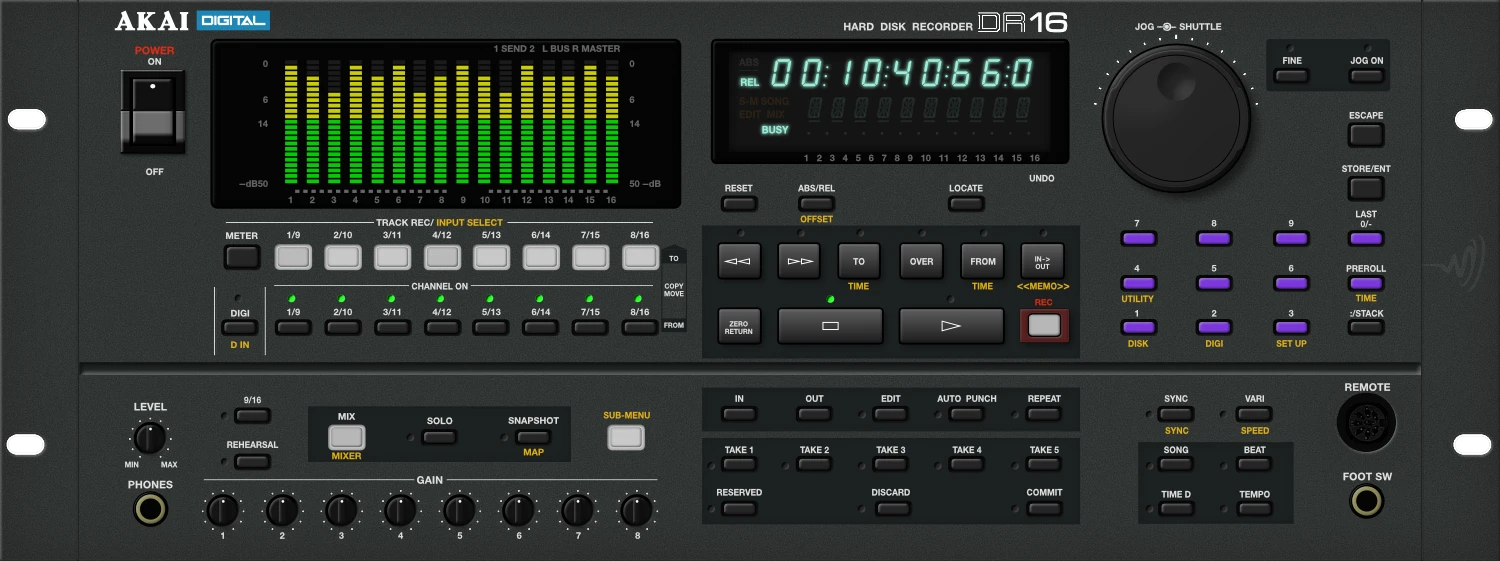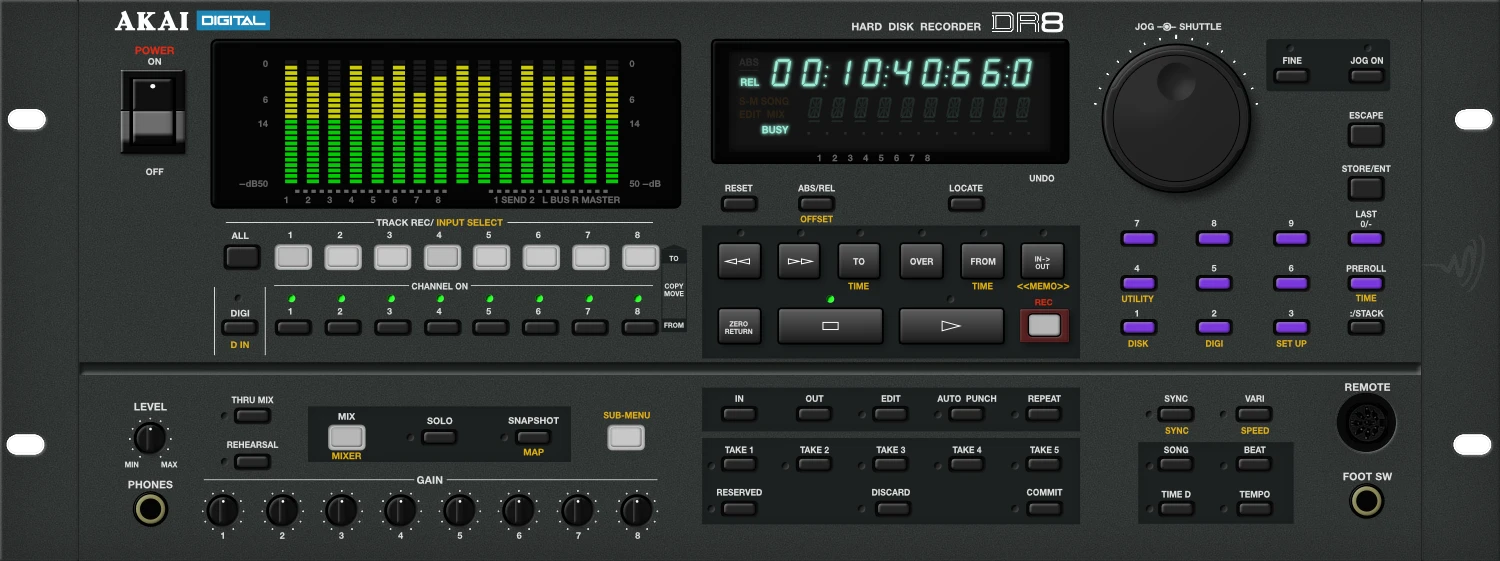In 1993, Akai introduced the now-legendary Akai DR4 four-track hard disk recorder and, for the first time, made the power and unmatched convenience of random-access digital recording available at a spectacularly affordable price. Today, thousands of DR4s are in use around the world in professional recording studios, radio and television stations, project studios, location recording facilities and home studios.
Now, with the Akai DR4d Version 4.0, Akai has taken affordable digital recording to the next level. Building on the power and flexibility of the original DR4, DR4d Version 4.0 further expands your creative horizons with our new VirtualTracks and Stereo Ping Pong capabilities.
You know the feeling. You’re down to that last track on your new song and it’s time for the guitar solo. On the third take you get one you like, but you wonder if you can do better. Do you record over the good take (and risk wishing you hadn’t)? Or keep it (and always wonder if you missed playing that perfect solo)?
Well, with the Akai DR4d Version 4.0’s VirtualTracks, you’ll never face that dilemma again. Because Version 4.0 gives you 250 virtual tracks to record your ideas on. 250 tracks to try out anything that comes to mind. Without having to give up anything you’ve already recorded.
Basically, each of the Akai DR4d Version 4.0’s four physical tracks can be assigned to play back any one of 250 virtual tracks. In the situation above, let’s say that you’ve recorded drums on tracks 1 and 2, bass on track 3. Record the first take of your guitar solo on track 4. Now each subsequent solo can be recorded on virtual tracks 5, 6, 7, and so on all the way up to track 250 (for those obsessive perfectionists among you). By simply assigning physical track 4 to any of the virtual tracks, you can audition each of your solos and pick your Favorite. Then either erase the others or keep a few of the better ones in case you change your mind later.
But let’s say you’re checking out those solos and you realise that although the first four bars of the solo on track 23 really scream, the last four bars are pretty lame. But the last three bars on track 15 are great. And in bar five there’s a lick on track 9 that you just know you’ll never play that well again. No problem. The DR4vr’s powerful editing functions let you combine any parts of any virtual tracks onto another virtual track. In perfect sync. Without the pressure of punching in. And without affecting any of the originals. Voila. Solo heaven.
And if that mind-boggling solo gives you ideas for a better bass part? Once again, no problem. Record new bass parts on free virtual tracks and then assign them one-by-one to physical track 3 to hear how they work. Of course, VirtualTracks have many more uses. Like radio spot production, where you can create a music bed and then record different voice-overs on different virtual tracks. Or experiment with various arrangements. (Does that accompaniment sound better on synth or guitar?) You get the idea.
Fixing it in the Mix
That’s all very nice, you might be saying, but there’s still really only four tracks, right? Well, yes and no. Because with Version 4.0’s Stereo Ping Pong function, you can perform stereo digital mixdowns from any two of the 250 virtual tracks. With level and pan control of each track. As many times as you want.
For instance, you can mix the drums down to tracks 1 and 2. Then mix down the bass from virtual track 7 with the drums on track 1 and 2. Add the backup vocals from 16 and 17. The piano from 154 and 155. The synth pad from 238 and 239. You can even go back and change the level and pan settings of any previously mixed tracks. And since the mixdowns happen in the digital domain, there’s none of the sonic degradation associated with ping-ponging tracks on an analogue tape machine.
Same As It Ever Was
Of course, in addition to these new features, the Akai DR4d Version 4.0 has all of the capabilities that made its predecessor a breakthrough. Like:
- Superb Akai sound quality, thanks to 18-bit, 64-times oversampling A/D and single-bit 18-bit dual D/A converters.
- 32 kHz, 44.1 kHz and 48 kHz sampling rates.
- Instantaneous locating to any of 108 programmable locate points. (This alone will save you hours of frustration. You’ll never want to put up with pokey tape winding again.)
- Easy-to use tape recorder-like controls.
- Responsive Jog/Shuttle wheel for locating edit points.
- Powerful nonlinear editing.
- Balanced analogue inputs and outputs with switchable +4dB/-10dB levels.
- AES/EBU and SCSI interfaces standard.
- Completely self-contained. No computer necessary.
- Available with an internal hard drive or connect up to seven SCSI hard disks or removable media like Iomega’s 1 GB JAZ drive.
Poised for Growth
As capable as the Akai DR4d is out-of-the-box, it has been designed to grow with your needs. Want more tracks? Link up to four DR4ds for up to 16 tracks. And control them all with the DL4d Remote Controller. Need to sync? Add a MIDI board for MTC and MMC or a SMPTE timecode reader/generator.
Want to operate completely in the digital domain? Then add a second digital I/O board for four-track digital recording and playback. Or add a second SCSI interface for M/O backup or to connect to a Macintosh to take advantage of Mark of the Unicorn’s WaveEdit graphic waveform-editing software.
The Bottom Line
Of course, none of this is worth anything if you can’t afford it, so we designed the Akai DR4d Version 4.0 to be a remarkable value. To find out just how remarkable, see your local Akai dealer. Check out the Akai DR4d Version 4.0. We’re virtually certain you’ll have to have one.




